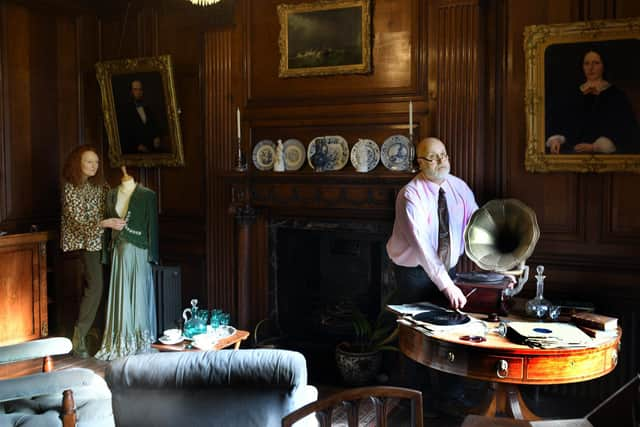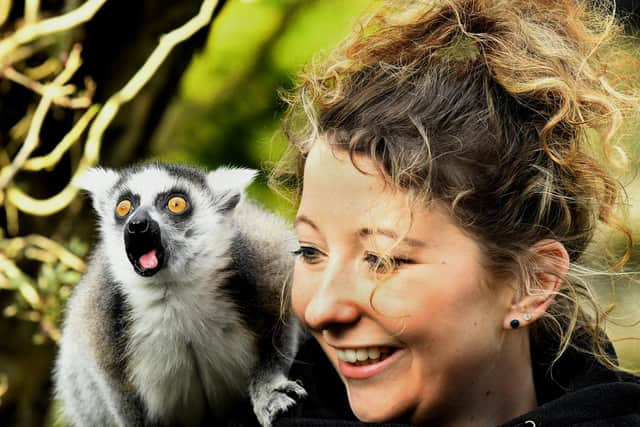This is what it's like to work inside 'giant dolls house' Sewerby Hall
Robert Chester chuckles as he recalls how a visitor to Sewerby Hall once likened it to a “big dolls’ house that we get to play in”.
“Especially when we’re dressed up,” he says. “We are the dolls then.”
Advertisement
Hide AdAdvertisement
Hide AdRobert is education officer at the site in Bridlington, which is made up of a historic country house, 50 acres of gardens and parkland and Sewerby Zoo and is operated by the East Riding of Yorkshire Council.


“It’s great fun. I love hearing the stories that people tell us when they visit. We’ve had a whole range of people – those who have been in service or whose fathers or grandfathers were butlers.
"They’ve all got stories to share which is brilliant. Some of those stories get incorporated then into what we tell other people about the site and are things we would never pick up otherwise.”
The ‘we’ he is referring to is a team of volunteers, who work in costume with visitors. They interpret the home’s heritage, bringing its story to life each Wednesday and Friday during its opening season. Some also make and maintain the Edwardian outfits that are worn during the interpretations or that are on display as part of the hall’s collection.


Advertisement
Hide AdAdvertisement
Hide Ad“The costume volunteers all joined us to make costumes – they didn’t intend to dress up, but they do now,” Robert says. “It’s a bit infectious really when you see how much fun people are having dressed up and interacting with the public. The costume interpretation really does bring the place to life. And the props we use are really good for engaging conversation.”
In character as a butler, Robert, who has worked at Sewerby since 2011 and was previously a secondary school teacher, also hears visitors’ thoughts on the house, an insight beneficial for his work away from the public eye.
His remit includes researching and creating activities and interactive opportunities for visitors, as well as devising and delivering programmes and workshops for pupils on school trips. “You learn a lot about the house and the displays (when you’re out in costume) because you’re observing people,” he explains.
“Not everyone wants to talk to you but you get to watch people and see how they use the site and how they react to certain things – and you get a feeling for what’s working and what isn’t so you can then adapt what you do accordingly.”
Advertisement
Hide AdAdvertisement
Hide AdRobert works closely with museum curator Janice Smith, who looks after the hall’s collection. Since an extensive restoration project in 2013-14, the building has been set out as a working country house in its Edwardian heyday and among its furnishings are pieces loaned from the national collection at London’s Victoria and Albert Museum.
“When the family that lived here sold up in the 1930s, they sold every bit of furniture, so what you see is largely on long-term loan,” Janice explains. “Much of the grand furniture is from the Victoria and Albert Museum. That’s a real coup for East Yorkshire.”
A grand country estate, Sewerby Hall and Gardens was sold to the Bridlington Corporation in 1934, by the Lloyd Greame family. Two years later, it was officially opened by pioneering Hull-born pilot Amy Johnson – and a collection of her personal memorabilia, donated by her family, is now on permanent display.
During the Second World War, the house was commandeered by the military and became a convalescent hospital for RAF service personnel, before being turned into a museum and an art gallery in the 1950s. It was restored to its Edwardian splendour using photographs from the period and auction inventories that detailed the house’s former furniture .
Advertisement
Hide AdAdvertisement
Hide AdJanice, who joined the Sewerby team in 2006, is responsible for the exhibition programme. As well as maintaining the permanent country house displays, she draws on the council’s museum collection – and loaned and donated items – to create temporary, changing exhibits.
Recent displays have included the rise of the seaside holiday and the Bridlington Peace Pageant held to mark the end of the First World War. “We like to celebrate this area of the coast,” she says. “This is a really significant area and we find that East Yorkshire is really under-sung so we make it our job to be loud and proud of it.”
Instilling pride is all in a day’s work for Sewerby’s head gardener too. Richard Spalding, who joined the site more than 30 years ago, is responsible for maintaining the grounds and each year, puts around 40,000 plants in place for the summer season.
“The biggest job is planting all the summer bedding,” he says. “And there’s all the spring bedding to take out. You want a quick turnover. That’s our busiest time of the year. In the summer, it’s all go. We could be in at five in the morning watering plants. It can be long days but you see the end product and you get some really great compliments from visitors.”
Advertisement
Hide AdAdvertisement
Hide AdThe job of head zoo manager John Pickering and assistant head zookeeper Melissa Tate, looking after the site’s collection of mammals and birds including micropigs, lemurs, pygmy goats and llamas, can extend far beyond a typical working day.
Seventeen years ago, John, who joined the zoo in 1979 straight from school, successfully hand-reared a penguin chick, caring for it at his home for three months. “It doesn’t stop on site here,” he says. “I’ve hand reared a baby monkey at home, otherwise it would have died, I’ve hand reared two penguins, a parrot. I take animals home if they need looking after.
“Hand rearing the penguins was very rewarding, particularly with the species being classed as vulnerable in the wild. I have a close bond with the penguins – they still come running over to me do the ones I hand-reared so that’s very rewarding.”
Melissa, who grew up in Leeds, has cared for a baby goat at home, bottle feeding it every four hours. “Sometimes if it wasn’t for us intervening some of these animals wouldn’t be here,” she says.
Advertisement
Hide AdAdvertisement
Hide AdThe pair are responsible for the feeding, cleaning and routine medical treatments of the animals, as well as running encounter experiences and question and answer sessions for visitors. Both reflect with sadness on the hardest part of their job – when their beloved animals pass on. But the close bond they have with the species they care for brings smiles all around.
“Part of the enjoyment is coming to work and seeing all the animals ready to greet you,” Melissa says. “But it’s also lovely seeing the customers happy at the animals. They share the same joy that we do and we’re able to provide visitors with a nice experience so they go away having had a good day. That’s really rewarding.”
Visit www.sewerbyhall.co.uk
